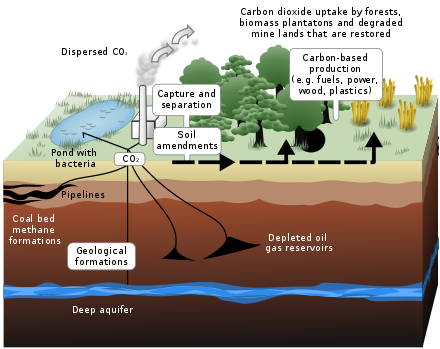Carbon Capture And Storage (CCS) Market Industry Analysis, Size, Growth, Trends and Forecast To 2025 : Grand View Research Inc.

The Concept
Carbon capture & storage (CCS), also known as ‘carbon capture and sequestration’ or ‘carbon control and sequestration’, is the method of capturing waste CO2 (carbon dioxide) from large point sources; for instance, fossil fuel plants. The captured carbon dioxide is then transferred to a storage space & usually deposited in an underground geological formation, from where it won’t enter the environment. This is a potential way of reducing the contribution of CO2 emissions to the process of global warming and ocean acidification through industries and heating. There is a possibility that the combination of CCS and Biomass to show net negative emissions.
A recent statement by the IEA and the UN Climate Panel summarized the high probability of climate change linked to CO2 emissions, with an added recommendation of reducing global CO2 emissions by 5 gigatons annually. Carbon capture & storage can be expected to contribute to the complete elimination of 14-17% of CO2 emissions. Currently, there are more than 40 large-scale facilities, with Chevron’s Gorgon plant one of the latest additions.
One of the more notable examples in the carbon capture & storage field is the Petra Nova, a joint venture between JX Nippon Oil & Gas Exploration Corp. and NRG Energy Inc., which developed a carbon-capture project at NRG’s W.A. Parish Generating Station. It is currently the world’s largest operating CCS system. The project is designed to capture approximately 90 % of the CO2; along with sulfur oxides, nitrogen oxides, and particulates from a 240 MW ‘flue-gas’ slipstream. This process requires about 1.6 million tons of greenhouse gas per annum. The system deploys an amine-based CO2 scrubber, designed by Mitsubishi Heavy Industries, to capture the gas in industrial applications.
‘Capturing’ attention across the globe
Carbon capture and storage is receiving a lot of support from industries as well as Governments across the world, with the common consensus being that carbon capture and storage goes a long way in delivering deep emissions reductions, particularly in industries such as cement, petrochemicals, fertilizer and steel, which make up for over 20% of the global emissions. The United Kingdom has begun a carbon capture project from the burning of wood. The project, known as Bio Energy with Carbon Capture and Storage (BECCS), is being carried out at the Drax Power Station in North Yorkshire, and is the first such project in Europe.
The Carbon capture and storage market is expected to see high growth in the coming years, with the following factors at play:
- The market is anticipated to be propelled by energy demand and ‘carbon dioxide’ reduction awareness.
- Strict Government regulations with regards to greenhouse gas emissions is also expected to drive the industry forward. Since 1997, there has been a 20-time increase in the number of global laws regarding climate change, which include more than 1200 policies across 164 countries that are responsible for GHG emissions.
- Wide adoption of gas injection for enhanced oil recovery (EOR) in various petroleum reserves worldwide is expected to drive industry demand in the near future.
- Under the Paris agreement, Carbon capture & storage has been recognized as being critical in reaching global climate goals by major climate change bodies such as IPCC and IEA, a factor which would help in enhancing the market attractiveness.
- With growth in the number of oil and gas industries, there is a high chance that the market will be populated further with competitive players.
The carbon capture & storage industry is not without its challenges though, with the complexity of the overall process causing an overall increase in costs. Also, there is no definitive opinion regarding underground carbon dioxide storage being totally secure, with scientists advising a continuous monitoring of the storage areas.
Major developments
Key participants in the carbon capture & storage market include:
- Linde Engineering
- Aker Solutions
- Sulzer
- Shell CANSLV
- Mitsubishi Heavy Industries, and
- Equinor (formerly Statoil)
The industry is primarily led by multiple oil & gas companies. Huge operational expenses & initial investments prevent novel players from entering the market. Discrepancies in governmental framework are one of their other concerns.
Some of the other major recent developments in the carbon capture and storage market include:
- In September 2019, the U.S. Department of Energy announced a federal funding of USD 110 Million for the purpose of Carbon capture, utilization, and storage, with USD 75 Million reserved for two funding opportunity announcements (FOAs) already announced this fiscal year, while USD 35 Million is for an upcoming FOA.
- In September 2019, Equinor and its partners Shell and Total, announced their involvement in the Northern Lights project, which involves transport, reception and the permanent storage of CO2 on the Norwegian continental shelf. More than 150 people from the 3 organizations have come together for the project, with plans to drill a confirmation well for CO₂ storage in the Johansen formation ready to be undertaken.
- In January 2019, Aker Solutions received its first contract on Northern Lights, with the organization expected to deliver subsea infrastructure equipment for an early well development. The organization is already working at Norcem’s cement factory located in Brevik with regards to engineering and design of a carbon capture plant, which will function as a capture site for the Northern Lights project.
In-depth report on global carbon capture and storage (CCS) market by Grand View Research:



Comments
Post a Comment